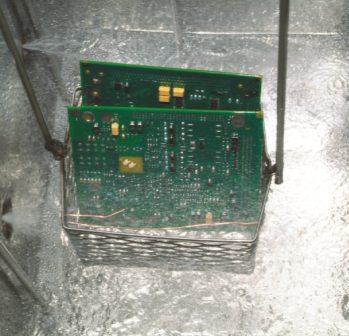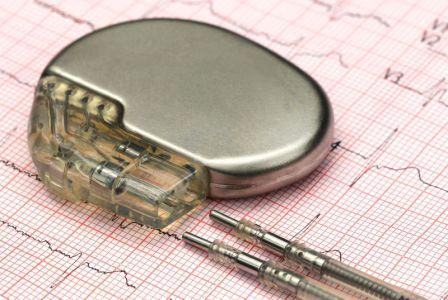Medical Electronics Cleaning 101: A Primer
New solvent technology in combination with vapor degreasing can meet rigorous reliability and environmental standards.
As technology advances, entire categories of solutions are being invented, shifting the way we communicate, do business and thrive as communities. Medical electronics is one of those categories that is changing healthcare as we know it, with implications related to improved quality of care and efficiency, lower costs, improved experiences and treatment processes and more. Technology in the medical field will continue to impact our livelihoods. With new products come new challenges, however. For medical equipment, one important consideration for manufacturers is how to best clean medical electronics safely and effectively.
Cleaning electronics is not a trivial task because of the risk involved and sensitive nature of the materials and engineering that need to be carefully constructed and maintained to function properly and keep the user safe. For medical electronics, the stakes are even higher.

FIGURE 1. For medical equipment, an important consideration is how to best clean medical electronics safely and effectively.
Cleaning Standards
Among the many reasons why proper cleaning of medical equipment is so important, two stand out: 1) the implications cleaning has for the next steps in the manufacturing process (for instance, sterilization) and 2) device performance. Take pacemakers, for example. Before shipping a new pacemaker out the door, manufacturers need to ensure any particulate, such as adhesives, coatings, finger residue or other material, is completely removed. Anything left on the product that isn’t meant to be there will negatively affect application of coatings or sterilization. With the wide variety of possible contaminants and increasingly miniature components of various geometries, cleaning continues to become more complex. Beyond removing harmful substances, cleaning is vital for the utility and function of medical electronic devices. The computing power and functionality of modern medical devices is directly proportional to the processing power of the printed circuit boards (PCBs) within them. Solder joints cause a large percentage of PCB failures, so cleaning is key to success. More sophisticated cleaning enables use of stronger, more active fluxes, which results in better solder joints. Problems with “cold joints,” insufficient wetting, bridging, and shorts can also be avoided. Better cleaning directly translates to more effective PCBs, which means more reliable medical electronics.
Medical electronics face strict regulation guidelines when it comes to design, manufacturing, certification and, of course, maintenance and cleaning. Where consumer electronics can be manufactured for “good enough” functionality, medical electronics have no room for error. Quality, predictability and safety are all priority concerns for the sake of patients and medical staff, and the hospital and product manufacturers that are liable. ISO 10993, issued by the International Organization for Standardization, evaluates devices within a risk management framework to ensure they are safe, assessing bioburden, pyrogens and sterility to ensure no harmful material remains on the tools depended on to provide care.
Under these guidelines, manufacturers are responsible for undergoing thorough validation before introducing any change in their manufacturing process, including new cleaning methods. Validated processes must prove to be consistently effective and repeatable – indefinitely – until the manufacturer chooses to undergo validation again. This rigorous process is costly in time, resources and energy, and few manufacturers willingly change course once an existing process is validated. Validation stresses the importance for companies to get it right the first time – not only with regard to the most effective cleaning process, but also the one that will be the most scalable, cost-efficient and adaptable long-term, especially as new product designs and solutions are introduced into the market.
Today’s Options
Manufacturers have choices when it comes to cleaning solutions – not only that stand up to regulations, but also that meet a number of other considerations, such as environmental impact, cost, efficiency, maintenance, machine clean room compatibility and more. As research has been conducted and equipment solutions have evolved, manufacturers have changed their preference for various cleaning agents over the years. It’s important decision makers understand what the options are today and how they can be best prepared for the future.
Historically, vapor degreasing was the default cleaning process for most industries when complex electronic equipment was introduced. However, concerns increased about the cleaning solvents’ environmental impact, and in the 1990s, aqueous cleaning was introduced and favored as a “greener” option. Aqueous cleaning was also accepted for its cheaper cost per volume of liquid, and at the time it was introduced, it worked well with the PCBs of that era. Until recently, aqueous cleaning methods have been the primary choice of many manufacturers in the industry.
Innovative new cleaning solvents have come a long way from the chemistry of decades past, however, and with new environmentally friendly properties, many manufacturers are revisiting and favoring the benefits that vapor degreasing with solvents can provide. For young engineers who may have never seen a vapor degreaser in their career and are unfamiliar with the thermodynamics involved, the process can seem magical, especially in contrast to the large, wet and noisy aqueous cleaning systems they are familiar with.
How Vapor Degreasing Works
Vapor degreasers (used for much more than cleaning greases, despite their generic name) are closed-loop systems that require two components: a specially designed cleaning machine and specific low-temp boiling nonflammable solvent as the cleaning agent. Inside are two chambers: the boil sump and the rinse sump – each descriptive of their purpose. In the boil sump, solvent is heated and parts are immersed and cleaned in the fluid. Once cleaned, parts are mechanically transferred to the rinse sump for final cleaning in a pure, uncontaminated fluid. Parts come out clean, dry, spot-free and immediately ready for the next step in the process.
This smooth operation has a number of advantages. For starters, while they range in size, vapor degreasers have a significantly smaller footprint than other options. In a clean room environment, space is money. To meet regulations of a validated process, clean rooms are strictly controlled spaces that regulate temperature, air quality and other safety measurements. The larger the square footage of these spaces, the more expensive they are to maintain.
Additionally, solvents boil at lower temperatures than water, so it takes less electricity to get things in motion. Vapor degreasers are known to be simpler to operate, requiring less training than more complex systems and fewer human resources to manage. Much of the cleaning activity in a vapor degreaser is automatically initiated – requiring only the touch of a button – in contrast to other cleaning methods that require more manual involvement or monitoring.
FIGURE 2. Manufacturers need to ensure any particulate such as adhesives, coatings, finger residue or other material is completely removed from pacemakers.
The Solvent Advantage
As it relates to performance, solvents are 20-40% heavier than water, which can aid in dislodging particulate more easily from components. Conversely, they have lower surface tension and lower viscosity than water, so they can more easily clean in small cracks and crevices, and quickly weep out rather than staying trapped. This becomes critical for a couple reasons: After cleaning, many products go into a coating stage. If any liquid remains on a piece of equipment, conformal coatings won’t stick like they should. Additionally, any trapped liquid poses threats to bacteria and pyrogen growth that are disastrous in a sterile environment or healthcare application. The combination of weight that will clear away particulate, with the low viscosity and surface tension getting them in and out of miniature spaces quickly, makes solvents an ideal agent for medical equipment or electronic cleaning. Cleaning fluid can be tailored to the application so that even delicate, intricate parts can be cleaned with consistent results.
While environmental regulations are still in place, concerns around solvents are no longer what they once were. In fact, modern solvents are greatly minimizing environmental issues; properly designed and maintained vapor degreasers are environmentally progressive. These modern, nonflammable solvent cleaning methods are making a major impact on short- and long-term reliability and performance of medical electronics equipment and devices, while lowering costs at the same time.
If efficacy alone wasn’t enough, the solvent liquid is indefinitely reusable when it regenerates itself in the heated vapor degreaser. The thermodynamics of the heated machine generates vapor that rinses, condenses back to liquid against refrigerated coils and overflows back into the boil sump, creating a self-recycling system. Properly handled, solvents never wear out or need to be replaced.

Figure 3. New solvents are making vapor degreasing a popular choice for their cleaning processes.
is senior vice president at MicroCare Medical (microcaremedical.com) and holder of numerous US patents for cleaning-related products; jayt@microcare.com.
Register now for PCB WEST, the largest trade show for the printed circuit and electronics industry in the Silicon Valley! Coming Sept. 11-13 to the Santa Clara Convention Center.





